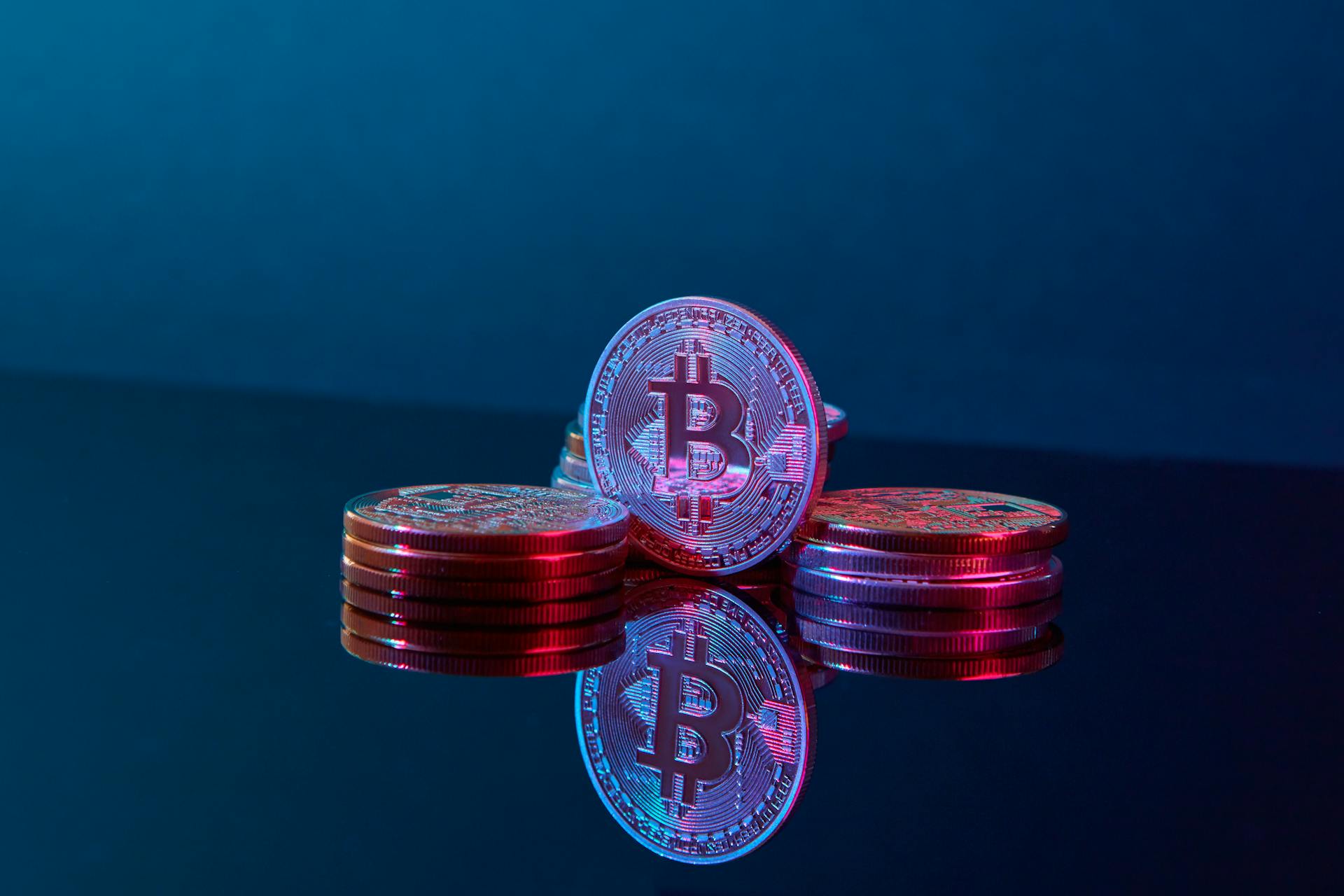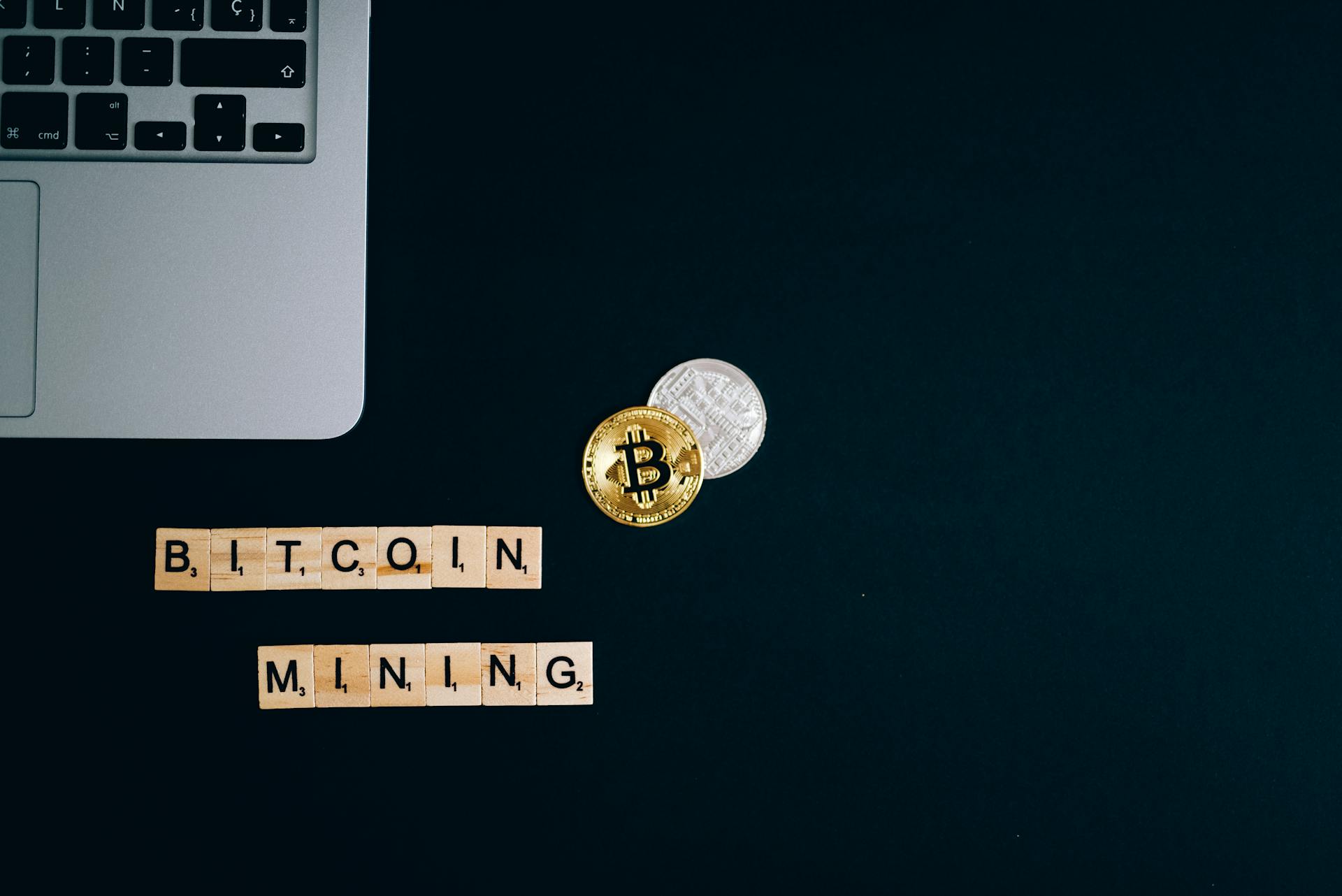
The total supply of Bitcoin is capped at 21 million, a number set by Satoshi Nakamoto, the creator of Bitcoin. This limit was established to prevent inflation and maintain the value of each Bitcoin.
The supply limit is hardcoded into the Bitcoin protocol, ensuring that it can't be altered or manipulated. This design choice has contributed to Bitcoin's reputation as a secure and trustworthy store of value.
The 21 million supply limit is divided into two main categories: mined Bitcoins and pre-mined Bitcoins. Mined Bitcoins are the ones generated through the process of mining, where powerful computers solve complex mathematical problems to validate transactions and create new Bitcoins.
Check this out: Where Are Bitcoins Mined
Bitcoin Supply
The total supply of Bitcoin is capped at 21 million, but due to a quirk in the blockchain's programming, it's likely that the actual number of Bitcoins issued will be slightly lower.
As of December 22, 2024, 19.9 million Bitcoins have been mined, leaving about 1.1 million Bitcoins to release. This means that miners have plenty of an incentive to keep mining the network.
For another approach, see: $230 Million Cryptocurrency Theft
The mining reward halving occurs every 210,000 blocks, which is approximately every 4 years. After 64 total halvings, there will be no more Bitcoins left to reward miners and all 21 million Bitcoins will be in circulation.
The final Bitcoin (or realistically, the final satoshi) is not expected to be generated until 2140, and the number of new Bitcoins minted per block has decreased from 50 to 3.125 since Bitcoin's establishment.
A study by Chainalysis estimated that up to 20% of the Bitcoin already issued may be permanently lost, which could affect the number of Bitcoins circulating.
Broaden your view: Ripple Labs Wins Final Judgment in Xrp Case against Sec.
What Happens After Mining Ends
Bitcoin mining will eventually come to an end, and no new bitcoins will be issued once the maximum number of 21 million is reached.
After mining ends, bitcoin transactions will continue to be processed, and miners will still be rewarded, but only with transaction processing fees.
Miners could charge high transaction fees to process high-value or large batches of transactions, making it possible for them to profit even with low transaction volumes.
See what others are reading: Why Are Bitcoins so High
Bitcoin's price could be greater once all 21 million BTC are mined due to deflationary pressure on the cryptocurrency.
The price parity between bitcoin and the US dollar will likely be very different if both are still around in the next century.
The number of new bitcoins issued per block will continue to decrease by half approximately every four years, with the final bitcoin (or satoshi) not expected to be generated until 2140.
Miners receive more than just block rewards when they create new blocks, they also earn transaction fees associated with each transaction.
Transaction fees will vary with network congestion and transaction size, and miners will prioritize transactions by the highest Satoshi/byte fee.
Once there are no bitcoins left for mining rewards, transaction fees should be high enough of an incentive for miners to continue running the network.
The mining reward halving occurs every 210,000 blocks, or about every four years, and after 64 total halvings, there will be no more bitcoins left to reward miners.
Up to 20% of the bitcoin already issued may be permanently lost, which could affect the number of bitcoins circulating.
Related reading: Moonpay Alternatives No Kyc
Mining and Fees
Bitcoin miners will likely continue charging mining fees when it reaches its limit.
Mining is the process of verifying transactions and opening new blocks, which will still need to be done.
Miners could charge high transaction fees to process high-value or large batches of transactions.
Mining fees may increase to compensate miners for their expenses.
Explore further: What Is Bitcoins All Time High
Bitcoin Mining Time
Bitcoin mining is a complex process that requires powerful computers and a lot of energy. As of 2024, a new block is produced approximately every 10 minutes.
The current block reward is 3.125 bitcoins, which is divided among crypto miners for generating a new block. This means that about 0.3125 bitcoins are mined per minute.
Here's a breakdown of the block reward and mining time:
In 2028, the block reward will halve to 1.5625 bitcoins, which will result in about 0.15625 bitcoins being mined per minute. This reduction in block reward will likely impact the mining process and transaction fees.
Suggestion: Block Reward
What Happens to Mining Fees When Bitcoin's Supply Limit Is Reached?
Mining fees will likely continue to be charged after Bitcoin reaches its supply limit. This is because mining is still necessary to verify transactions and open new blocks.
As the sole reward for miners, mining fees may increase to compensate them for their expenses. This could happen as miners try to make up for the loss of block rewards.
Miners could charge high transaction fees to process high-value or large batches of transactions. This is especially true if Bitcoin is used primarily as a store of value rather than for daily purchases.
The Lightning Network, a "layer 2" blockchain, could help facilitate daily bitcoin spending by working with the Bitcoin blockchain. This could lead to increased transaction volumes and higher fees for miners.
Expand your knowledge: Bitcoins Transactions per Second
Regenerative Finance 101: A Guide to ReFi
There are only 21 million Bitcoins that will ever exist, and currently, around 19 million are available.
The remaining 1,984,000 Bitcoins aren't in circulation yet, waiting to be mined by the network's validators.
Suggestion: 1 Million Bitcoins
Out of the 19 million available Bitcoins, it's estimated that 30% may be lost forever due to hard drive crashes and misplaced private keys.
These lost Bitcoins are gone for good and can't be recovered.
The remaining Bitcoins not in circulation are in a pool dedicated to rewarding miners for maintaining the network's integrity.
See what others are reading: How Many Lost Bitcoins
Bitcoin Value and Availability
The number of Bitcoins is capped at 21 million, but that doesn't mean it will reach that exact number. Due to a process called halving, the total number of Bitcoins issued is likely to fall slightly short of 21 million.
The halving occurs every 210,000 blocks, which is about every 4 years. This means that after 64 total halvings, there will be no more Bitcoins left to reward miners and all 21 million Bitcoins will be in circulation.
Miners receive more than just the block rewards when they create new blocks - they also earn the fees associated with each transaction. Transaction fees vary with the amount of network congestion and transaction size.
The total supply of Bitcoins could be just one or a trillion, and it wouldn't make a difference in the grand scheme. The value of Bitcoin is always relative, and doubling the total number of Bitcoins simply halves the value of a single one.
The final Bitcoin (or realistically, the final satoshi) is not expected to be generated until 2140, or possibly earlier. This is because the number of new Bitcoins minted per block decreases by half approximately every four years.
Up to 20% of the Bitcoin already issued may be permanently lost, which means the number of Bitcoins circulating remains substantially below 21 million.
The Bottom Line
The Bitcoin ecosystem is still developing, making it possible that Bitcoin itself will continue to evolve over the coming decades.
The supply limit of 21 million coins is a significant factor that will impact Bitcoin miners, who will no longer be able to mine new bitcoins.
No new bitcoins will be released after the limit of 21 million coins is reached, which could have adverse effects on Bitcoin investors.
On a similar theme: Robinhood Crypto Transfer Limit
Origin and Miscellaneous
The million bitcoins milestone is a significant one, and it's interesting to explore its origin. The first block of the Bitcoin blockchain, known as the Genesis Block, was mined in 2009.
Bitcoin was created by an individual or group using the pseudonym Satoshi Nakamoto. Their true identity remains unknown.
The Genesis Block contained a message referencing the Times of London newspaper's headline from that day, which was "Chancellor on brink of second bailout for banks." This message has been interpreted as a commentary on the financial crisis at the time.
The Genesis Block also contained a timestamp, which marked the beginning of the Bitcoin blockchain. This timestamp is a crucial part of the blockchain's integrity and functionality.
The Genesis Block was mined on January 3, 2009, and it contained no transactions. It was simply a starting point for the blockchain.
Recommended read: What Is a Bitcoin Miner
Frequently Asked Questions
Who owns 1.1 million Bitcoin?
The estimated owner of 1.1 million Bitcoin is Satoshi Nakamoto, the creator of Bitcoin. This significant amount of Bitcoin was accumulated by Nakamoto through their early mining efforts.
How much is $1 Bitcoin in US dollars?
As of now, 1 Bitcoin is equivalent to approximately $92,481 in US dollars. Check our site for the latest updates on the BTC to USD exchange rate.
Can Bitcoin reach $1 million?
While some long-term projections suggest Bitcoin could reach $1.77 million by 2050, it's essential to note that near-term expectations are more modest, with a focus on the $200,000 level by 2025. To understand the potential for Bitcoin to reach $1 million, consider exploring the varying forecasts and market trends.
Sources
- https://www.investopedia.com/tech/what-happens-bitcoin-after-21-million-mined/
- https://coincentral.com/how-many-bitcoins-are-left/
- https://www.lightspark.com/learn/bitcoin/when-all-21-million-bitcoins-are-mined
- https://www.elliptic.co/blockchain-basics/why-there-will-only-ever-be-21-million-bitcoins
- https://medium.com/@k_schellinger/understanding-bitcoins-21-million-limit-310297a7d962
Featured Images: pexels.com


